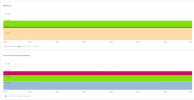- Server operating system version
- Ubuntu 20.04 aarch64
- Plesk version and microupdate number
- Plesk Obsidian 18.0.47.5
Hi,
I have 2 ARM Server of 24 GB RAM and 4 CPU. I have around 6-10 normal website hosted in each of them but plesk consume 80% of RAM and i am not sure what it being used. I checked both plesk on same configuration and both plesk consume similar resource.

Fun facts is, i have another server with 1 CPU, 1GB RAM and AMD processor. It have around 15 website hosted in it and it still have 40% free memory.
Is this problem with Plesk?
I have 2 ARM Server of 24 GB RAM and 4 CPU. I have around 6-10 normal website hosted in each of them but plesk consume 80% of RAM and i am not sure what it being used. I checked both plesk on same configuration and both plesk consume similar resource.

Fun facts is, i have another server with 1 CPU, 1GB RAM and AMD processor. It have around 15 website hosted in it and it still have 40% free memory.
Is this problem with Plesk?


